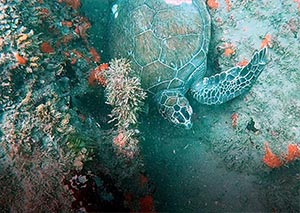Grant: 20-030R
Project Title: The Efficacy of Mitigation Reefs for Marine Turtles
Project Manager: Karen Holloway-Adkins
Organization: East Coast Biologists, Inc. (Non-Profit Organization)
Grant Amount: $20,486.00
Completion Date: 2021-11-15
Summary: The purpose of this study is to identify marine turtle use of artificial reefs that were installed to mitigate the impact of Brevard County's Beach Restoration Project. Mitigation reefs were built in advance of the Project, which while enhancing the nesting beach habitat for marine turtles, will inadvertently bury a portion of inter-tidal and shallow subtidal (0-3m water depth) hardbottom reef habitat used by juvenile green turtles. The mitigation reefs (installed in approximately 5 m water depth) were purposefully designed to provide suitable substrate for the attachment and growth of foraging resources (macroalgae) and create refuge (ledges) for small size-class green turtles (mean ~30 cm SCL). During preliminary observations, juvenile green as well as loggerhead (adult and subadult life stages) sea turtles were seen on and around the mitigation reefs. Our objectives are to: (1) add four acoustic receivers to the existing network of nearshore receivers and position these to detect turtle presence at mitigation reefs sites, (2) capture, lavage, and acoustically tag juvenile green turtles (n=7) from the nearshore reef and juvenile green turtles (n=8) from mitigation reef sites to track their use of mitigation reef resources, and (3) assess the abundance of available food resources through video and algae sampling of nearshore vs. mitigation reefs, and (4) compare resource assessment data with algae present in juvenile green turtle foraging samples (lavage). Results: Based on tracking data and recapture events, we confirm that the mitigation reefs installed in Brevard County provide resources for similar-sized juvenile green turtles that use the nearshore hardbottom reef. A complete manuscript of this study is targeted for completion in early 2022. The final publication will provide some of the first detailed accounts of marine turtles using artificial reefs. This work supports Florida Fish and Wildlife Conservation Commission's goal to promote the protection of marine habitat that are used by Florida's marine turtles in minimizing loss of important nearshore foraging habitat during beach restoration activities. This project successfully determined aspects on the viability of creating artificial reef areas to mitigate for 'like' habitat in nearshore waters.
Results: Based on tracking data and recapture events, we confirm that the mitigation reefs installed in Brevard County provide resources for similar-sized juvenile green turtles that use the nearshore hardbottom reef. A complete manuscript of this study is targeted for completion in early 2022. The final publication will provide some of the first detailed accounts of marine turtles using artificial reefs. This work supports Florida Fish and Wildlife Conservation Commission's goal to promote the protection of marine habitat that are used by Florida's marine turtles in minimizing loss of important nearshore foraging habitat during beach restoration activities. This project successfully determined aspects on the viability of creating artificial reef areas to mitigate for 'like' habitat in nearshore waters.